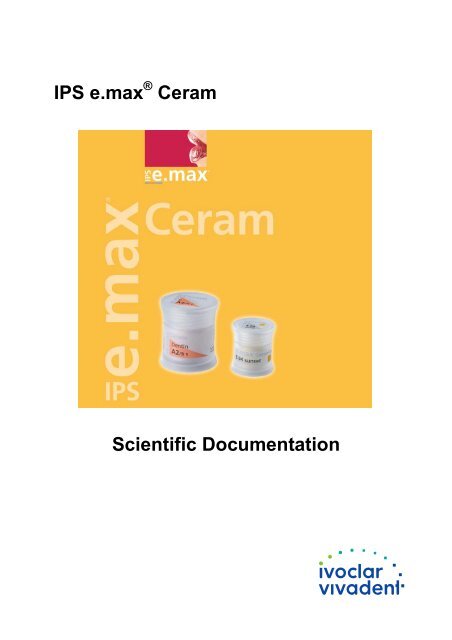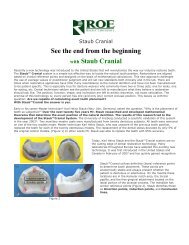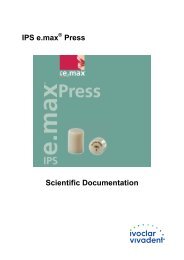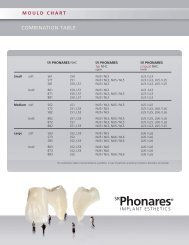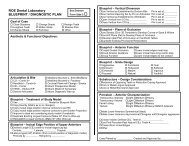IPS e.max Ceram Scientific Documentation - ROE Dental Laboratory
IPS e.max Ceram Scientific Documentation - ROE Dental Laboratory
IPS e.max Ceram Scientific Documentation - ROE Dental Laboratory
You also want an ePaper? Increase the reach of your titles
YUMPU automatically turns print PDFs into web optimized ePapers that Google loves.
<strong>IPS</strong> e.<strong>max</strong> ® <strong>Ceram</strong><br />
<strong>Scientific</strong> <strong>Documentation</strong>
<strong>Scientific</strong> <strong>Documentation</strong> <strong>IPS</strong> e.<strong>max</strong> ® <strong>Ceram</strong> Page 2 of 21<br />
Table of contents<br />
1. Introduction................................................................................................................... 3<br />
1.1 Overview of <strong>IPS</strong> e.<strong>max</strong> range of products ..................................................................................... 3<br />
1.2 <strong>IPS</strong> e.<strong>max</strong> <strong>Ceram</strong>............................................................................................................................. 4<br />
1.2.1 Microstructure and aesthetic properties .................................................................................. 4<br />
2. Technical data............................................................................................................... 6<br />
3. Material science investigations ................................................................................... 8<br />
3.1 Comparative data with other veneering ceramics of Ivoclar Vivadent AG .................................. 8<br />
3.2 Compatibility with <strong>IPS</strong> e.<strong>max</strong> materials .......................................................................................... 8<br />
3.2.1 Coefficient of thermal expansion ............................................................................................ 8<br />
3.2.2 Bond .......................................................................................................................................... 9<br />
3.3 Comparative data of veneering ceramics for zirconium oxide.................................................... 11<br />
3.3.1 Coefficient of thermal expansion .......................................................................................... 11<br />
3.3.2 Flexural strength (ISO 6872) ................................................................................................. 11<br />
3.3.3 Firing temperature .................................................................................................................. 12<br />
4. In vitro investigations................................................................................................. 13<br />
4.1 Fracture toughness of veneered bridges ..................................................................................... 13<br />
4.2 Veneering of zirconium oxide frameworks ................................................................................... 14<br />
5. External clinical studies ............................................................................................. 15<br />
5.1 University of Frankfurt a.M., Germany ......................................................................................... 15<br />
5.2 Boston University, U.S.A............................................................................................................... 15<br />
5.3 University of Connecticut Health Center, U.S.A. ......................................................................... 15<br />
5.4 University of Iowa, U.S.A............................................................................................................... 16<br />
5.5 Pacific <strong>Dental</strong> Institute, U.S.A....................................................................................................... 16<br />
5.6 University of Michigan, U.S.A. ...................................................................................................... 16<br />
5.7 University of Munich, Germany..................................................................................................... 17<br />
5.8 University of Heidelberg, Germany............................................................................................... 17<br />
5.9 University of Aachen, Germany .................................................................................................... 17<br />
5.10 University of Freiburg, Germany................................................................................................. 18<br />
5.11 Conclusions.................................................................................................................................. 18<br />
6. Biocompatibility.......................................................................................................... 19<br />
6.1 Introduction..................................................................................................................................... 19<br />
6.2 Chemical durability ........................................................................................................................ 19<br />
6.3 In vitro cytotoxicity.......................................................................................................................... 19<br />
6.4 Sensitization, irritation ................................................................................................................... 19<br />
6.5 Radioactivity ................................................................................................................................... 20<br />
6.6 Conclusions.................................................................................................................................... 20<br />
7. References .................................................................................................................. 21
<strong>Scientific</strong> <strong>Documentation</strong> <strong>IPS</strong> e.<strong>max</strong> ® <strong>Ceram</strong> Page 3 of 21<br />
1. Introduction<br />
1.1 Overview of <strong>IPS</strong> e.<strong>max</strong> range of products<br />
<strong>IPS</strong> e.<strong>max</strong> is an all-ceramic system that consists of the following five components:<br />
• <strong>IPS</strong> e.<strong>max</strong> Press (lithium disilicate glass-ceramic ingot for the press technique)<br />
• <strong>IPS</strong> e.<strong>max</strong> ZirPress (fluorapatite glass-ceramic ingot for the press-on technique)<br />
• <strong>IPS</strong> e.<strong>max</strong> CAD (lithium disilicate glass-ceramic block for the CAD/CAM technique)<br />
• <strong>IPS</strong> e.<strong>max</strong> ZirCAD (zirconium oxide block for the CAD/CAM technique)<br />
• <strong>IPS</strong> e.<strong>max</strong> <strong>Ceram</strong> (fluorapatite veneering ceramic)
<strong>Scientific</strong> <strong>Documentation</strong> <strong>IPS</strong> e.<strong>max</strong> ® <strong>Ceram</strong> Page 4 of 21<br />
1.2 <strong>IPS</strong> e.<strong>max</strong> <strong>Ceram</strong><br />
<strong>IPS</strong> e.<strong>max</strong> <strong>Ceram</strong> is a veneering ceramic designed for use in conjunction with the <strong>IPS</strong> e.<strong>max</strong><br />
all-ceramic system, consisting of SiO 2-LiO 2-Na 2O-K 2O-Al 2O 3-CaO-P 2O 5-F. As <strong>IPS</strong> e.<strong>max</strong><br />
<strong>Ceram</strong> uses an optimized combination of low firing temperature and CTE, it can be applied to<br />
all <strong>IPS</strong> e.<strong>max</strong> materials: <strong>IPS</strong> e.<strong>max</strong> Press, <strong>IPS</strong> e.<strong>max</strong> ZirPress, <strong>IPS</strong> e.<strong>max</strong> CAD and<br />
<strong>IPS</strong> e.<strong>max</strong> ZirCAD.<br />
The composition, physical properties and firing temperature of <strong>IPS</strong> e.<strong>max</strong> <strong>Ceram</strong> are similar<br />
to those of <strong>IPS</strong> Eris for E2. Therefore, the results achieved for <strong>IPS</strong> Eris for E2 also apply to<br />
<strong>IPS</strong> e.<strong>max</strong>.<br />
1.2.1 Microstructure and aesthetic properties<br />
<strong>IPS</strong> e.<strong>max</strong> <strong>Ceram</strong> contains glass ceramic and fluorapatite crystals, i.e. Ca 5(PO 4) 3F. The<br />
material does not contain feldspar or leucite. The fluorapatite crystals incorporated into the<br />
ceramic vary in size (Fig. 1). The crystals can be grown to the desired dimension by means<br />
of controlled nucleation and crystallization. The nanoscale fluorapatite crystals are less than<br />
300 nm in length and approx. 100 nm in diameter (Fig. 2). Additionally, fluorapatite crystals<br />
that have been grown along the longitudinal axis are also present; they measure 2-5 µm in<br />
length and less than 300 nm in diameter (Fig. 1). The surfaces of the cross-sections appear<br />
either square or circular, depending on the orientation of the crystals in the ground section of<br />
the specimen.<br />
The nanoscale fluorapatite crystals are responsible for the material’s opalescence (see Fig. 3<br />
-Fig. 5) and therefore contribute to its aesthetic properties. The material’s opacity (level of<br />
transparency) is mainly determined by the larger fluorapatite crystals.<br />
Optical effects, such as opalescence, brightness, opacity and translucency, can be adjusted<br />
in a targeted fashion with <strong>IPS</strong> e.<strong>max</strong> <strong>Ceram</strong> due to the light scattering effect produced by the<br />
differently sized fluorapatite crystals.<br />
Fig. 1: Microstructure of <strong>IPS</strong> e.<strong>max</strong> <strong>Ceram</strong> (SEM<br />
image): fluorapatite crystals in different sizes<br />
Fig. 2: Microstructure of <strong>IPS</strong> e.<strong>max</strong> <strong>Ceram</strong> (SEM<br />
image): fluorapatite crystals in the nanometer<br />
range
<strong>Scientific</strong> <strong>Documentation</strong> <strong>IPS</strong> e.<strong>max</strong> ® <strong>Ceram</strong> Page 5 of 21<br />
Fig. 3: Opalescence: longwave (red) and shortwave (blue) light is scattered differently by the nanofluorapatite<br />
crystals<br />
Fig. 4: Opalescence: the material assumes a<br />
bluish tinge against incident light<br />
Nano- fluorapatite<br />
300 to 500 nm<br />
Fig. 5: Opalescence: The material appears<br />
reddish/orange against transmitted light
<strong>Scientific</strong> <strong>Documentation</strong> <strong>IPS</strong> e.<strong>max</strong> ® <strong>Ceram</strong> Page 6 of 21<br />
2. Technical data<br />
<strong>IPS</strong> e.<strong>max</strong> <strong>Ceram</strong><br />
Veneering materials: Dentin, Deep Dentin, Occlusal Dentin, Margin, Incisal Edge, Transparent Incisal,<br />
Special, Transparent, Cervical Transparent, Opal Effect, Mamelon<br />
Add-on materials: Dentin, Incisal, Margin<br />
ZirLiner<br />
Standard composition: (in wt %)<br />
Veneering<br />
materials<br />
Add-on materials ZirLiner<br />
SiO2 60.0 - 65.0 61.0 – 68.0 50.0 – 60.0<br />
Al2O3 8.0 - 12.0 5.0 – 8.0 16.0 - 22.0<br />
Na2O 6.0 – 9.0 5.0 – 8.0 6.0 – 11.0<br />
K2O 6.0 – 8.0 5.0 – 8.0 4.0 – 8.0<br />
ZnO 2.0 – 3.0 2.0 – 4.0 ---<br />
+ CaO, P2O5, F 2.0 – 6.0 2.0 – 5.0 2.5 – 7.5<br />
+ other oxides 2.0 – 8.5 1.5 – 9.0 1.5 – 8.0<br />
+ Pigments 0.1 – 1.5 0.1 - 0.7 0.1 – 3.0<br />
Physical properties:<br />
In compliance with:<br />
ISO 6872 <strong>Dental</strong> ceramic<br />
ISO 9693 Metal-ceramic dental restorative systems<br />
Veneering<br />
materials<br />
Add-on materials ZirLiner<br />
Biaxial flexural strength MPa 90 ± 10 90 ± 10 90 ± 10<br />
Chemical solubility µg/cm² 15 ± 5 15 ± 5 15 ± 5<br />
Coefficient of thermal expansion<br />
(100 - 400 °C)<br />
10 -6 K -1 9.5 ± 0.25 9.5 ± 0.25 9.8 ± 0.25<br />
Glass transition temperature (Tg) °C 490 ± 10 470 ± 10 645 ± 10
<strong>Scientific</strong> <strong>Documentation</strong> <strong>IPS</strong> e.<strong>max</strong> ® <strong>Ceram</strong> Page 7 of 21<br />
<strong>IPS</strong> e.<strong>max</strong> <strong>Ceram</strong><br />
Shade, Essence, Glaze<br />
Standard composition: (in wt %)<br />
Shade Essence Glaze<br />
powder<br />
Glaze<br />
pastes<br />
SiO2 61.0 - 68.0 61.0 - 68.0 61.0 - 68.0 61.0 - 68.0<br />
Al2O3 5.0 - 8.0 5.0 - 8.0 5.0 - 8.0 5.0 - 8.0<br />
Na2O 5.0 - 8.0 5.0 - 8.0 5.0 - 8.0 5.0 - 8.0<br />
K2O 5.0 - 8.0 5.0 - 8.0 5.0 - 8.0 5.0 - 8.0<br />
ZnO 2.0 - 4.0 2.0 - 4.0 2.0 - 4.0 2.0 - 4.0<br />
+ other oxides 3.5 – 17.0 3.5 – 17.0 3.5 – 17.0 3.5 – 17.0<br />
+ Pigments 10.0 - 20.0 0.4 - 25.0 0.0 - 1.0 0.0 - 1.0<br />
+ Glycerine 20.0 - 25.0 --- --- 20.0 - 25.0<br />
+ 1,3 - Butandiol 15.0 - 20.0 --- --- 15.0 - 20.0<br />
Physical properties:<br />
In compliance with:<br />
ISO 6872 <strong>Dental</strong> ceramic<br />
ISO 9693 Metal-ceramic dental restorative systems<br />
Chemical solubility µg/cm 2<br />
Coefficient of thermal expansion<br />
(100 - 400 °C)<br />
Shade Essence Glaze Glaze<br />
pastes<br />
30 ± 10 30 ± 10 10 ± 5 10 ± 5<br />
10 -6 K -1 9.3 ± 0.5 9.3 ± 2.5 9.5 ± 0.25 9.5 ± 0.25<br />
Glass transition temperature (Tg) °C 475 ± 10 475 ± 10 470 ± 10 470 ± 10
<strong>Scientific</strong> <strong>Documentation</strong> <strong>IPS</strong> e.<strong>max</strong> ® <strong>Ceram</strong> Page 8 of 21<br />
3. Material science investigations<br />
3.1 Comparative data with other veneering ceramics of Ivoclar Vivadent AG<br />
CTE 100-400°C<br />
[10 -6 K -1 ]<br />
<strong>IPS</strong> e.<strong>max</strong><br />
<strong>Ceram</strong><br />
<strong>IPS</strong> Eris for E2<br />
9.50 ± 0.25 9.75 ± 0.25<br />
Glass transition point Tg [°C] 490 ± 10 485 ± 10<br />
Biaxial strength [MPa] 90 ± 10 85±25<br />
Vickers hardness [MPa] 5400 ± 200 5600 ± 200<br />
Chemical solubility [µg/cm 2 ] 15 ± 5 20 ± 10<br />
Firing temperature[°C] 750 / 760 755<br />
Type of material fluorapatite glass ceramic<br />
Amount of fluorapatite in the<br />
glass ceramic [% by wt]<br />
19 – 23 28 - 48<br />
Table 1: Comparative data with other veneering ceramics<br />
3.2 Compatibility with <strong>IPS</strong> e.<strong>max</strong> materials<br />
3.2.1 Coefficient of thermal expansion<br />
The linear thermal expansion of materials is measured with a dilatometer. A common way of<br />
measuring thermal expansion is by taking a length of material, heating/cooling it continuously<br />
and recording the resultant changes in length. This change in length may occur in a steady<br />
or discontinuous curve. A jump in the curve can be seen if a phase transition occurs in the<br />
material. The linear coefficient of thermal expansion (CTE) is determined per unit length for 1<br />
degree change in temperature (1 Kelvin). The CTE largely depends on the temperature<br />
range within which it is measured. Hence, it is important to indicate the temperature range<br />
over which the CTE is determined, as the CTE alone does not have much informative value.<br />
The CTE of dental ceramics is determined within a temperature range that includes<br />
temperatures below the glass transition point (Tg). The CTE is utilized to identify potential<br />
stress levels that the ceramic may have to endure in conjunction with the framework and/or<br />
layering material. Glass ceramics at temperatures above the Tg value are soft and the stress<br />
is dissipated by the flow of the material.<br />
According to ISO 9693, the CTE is expressed in [10 -6 K -1 ]; the CTE is often also indicated as<br />
[1µm/m·K].<br />
The coefficient of thermal expansion provides a clue as to whether the layering material is<br />
compatible with the framework material.<br />
<strong>Ceram</strong>ic materials are very susceptible to tensile stress. As a consequence, the coefficient of<br />
thermal expansion (CTE) of the layering material should be lower than that of the more rigid<br />
framework material (Fig. 6).
<strong>Scientific</strong> <strong>Documentation</strong> <strong>IPS</strong> e.<strong>max</strong> ® <strong>Ceram</strong> Page 9 of 21<br />
CTE (100°-400°C) [10 -6 K -1 ]<br />
11.5<br />
11<br />
10.5<br />
10<br />
9.5<br />
9<br />
8.5<br />
8<br />
<strong>IPS</strong> e.<strong>max</strong><br />
<strong>Ceram</strong><br />
<strong>IPS</strong> e.<strong>max</strong><br />
ZirPress<br />
<strong>IPS</strong> e.<strong>max</strong><br />
Press<br />
Fig. 6: CTE of <strong>IPS</strong> e.<strong>max</strong> materials (Ivoclar Vivadent Schaan, 2005)<br />
<strong>IPS</strong> e.<strong>max</strong><br />
CAD<br />
<strong>IPS</strong> e.<strong>max</strong><br />
ZirCAD<br />
� The CTE of the <strong>IPS</strong> e.<strong>max</strong> <strong>Ceram</strong> layering material is lower than that of the<br />
framework materials of the <strong>IPS</strong> e.<strong>max</strong> range.<br />
3.2.2 Bond<br />
The bond between <strong>IPS</strong> e.<strong>max</strong> <strong>Ceram</strong> and the other <strong>IPS</strong> e.<strong>max</strong> materials can be clearly seen<br />
in the SEM images below. The “compo contrast" image has been produced with a special<br />
imaging technique: The different materials of the samples are depicted in various degrees of<br />
brightness in line with signal transmitted from the backscattering electrons (BSE). The signal<br />
is affected by the composition of the individual materials.<br />
<strong>IPS</strong> e.<strong>max</strong> <strong>Ceram</strong> forms a homogeneous, flawless bond with the materials of the <strong>IPS</strong> e.<strong>max</strong><br />
range (Fig. 7 to Fig. 12).<br />
Fig. 7: Transition between <strong>IPS</strong> e.<strong>max</strong> <strong>Ceram</strong><br />
(above) and <strong>IPS</strong> e.<strong>max</strong> ZirPress (below); (ground<br />
surface, etched)<br />
Fig. 8: Homogeneous, flawless bond between<br />
<strong>IPS</strong> e.<strong>max</strong> <strong>Ceram</strong> (above) and <strong>IPS</strong> e.<strong>max</strong> CAD;<br />
(“compo contrast”; polished surface)
<strong>Scientific</strong> <strong>Documentation</strong> <strong>IPS</strong> e.<strong>max</strong> ® <strong>Ceram</strong> Page 10 of 21<br />
Fig. 9: Homogeneous bond between <strong>IPS</strong> e.<strong>max</strong><br />
<strong>Ceram</strong> (above), <strong>IPS</strong> ZirLiner and <strong>IPS</strong> e.<strong>max</strong><br />
ZirCAD; (“compo contrast”; polished surface)<br />
Fig. 11: Homogeneous sintered structure and<br />
compact bond between <strong>IPS</strong> e.<strong>max</strong> Press<br />
(below) and <strong>IPS</strong> e.<strong>max</strong> <strong>Ceram</strong>; (“compo<br />
contrast”; polished surface)<br />
Fig. 10: Homogeneous bond between <strong>IPS</strong> e.<strong>max</strong><br />
ZirLiner and <strong>IPS</strong> e.<strong>max</strong> ZirCAD; (“compo<br />
contrast”; polished surface)<br />
Fig. 12: Compact bond between <strong>IPS</strong> e.<strong>max</strong><br />
Press and <strong>IPS</strong> e.<strong>max</strong> <strong>Ceram</strong>; (“compo<br />
contrast; polished surface)
<strong>Scientific</strong> <strong>Documentation</strong> <strong>IPS</strong> e.<strong>max</strong> ® <strong>Ceram</strong> Page 11 of 21<br />
3.3 Comparative data of veneering ceramics for zirconium oxide<br />
3.3.1 Coefficient of thermal expansion<br />
CTE (100-400°C)<br />
10.5<br />
10<br />
9.5<br />
9<br />
8.5<br />
8<br />
7.5<br />
CTE 100-400 9.5 9.7 9.6 9.3 9.1 9.1 8.2<br />
Fig. 13: CTE (100-400°C) of veneering ceramics for use in conjunction with zirconium oxide<br />
(Ivoclar Vivadent AG Schaan, 2004/05)<br />
� Most veneering ceramics designed for use in conjunction with zirconium oxide feature<br />
a similar coefficient of thermal expansion.<br />
3.3.2 Flexural strength (ISO 6872)<br />
Biaxial flexural strength [MPa]<br />
160<br />
140<br />
120<br />
100<br />
80<br />
60<br />
40<br />
20<br />
0<br />
e.<strong>max</strong><br />
<strong>Ceram</strong><br />
e.<strong>max</strong><br />
C e r a m<br />
Lava<br />
<strong>Ceram</strong><br />
e.<strong>max</strong><br />
<strong>Ceram</strong><br />
# 2<br />
Cercon C<br />
S<br />
e.<strong>max</strong><br />
<strong>Ceram</strong><br />
# 3<br />
Nobel<br />
Z r<br />
Nobel Zr<br />
V M 9<br />
Cerabien<br />
CZR<br />
Cercon<br />
<strong>Ceram</strong><br />
S<br />
VM9 Triceram<br />
Cercon<br />
<strong>Ceram</strong><br />
# 2<br />
M e a n 1 1 0 9 4 9 0 1 0 2 9 6 8 4 6 3 8 1 8 1 6 6<br />
Fig. 14: Flexural strength values of various veneering ceramics (#2, #3: different batches) designed for use<br />
in conjunction with zirconium oxide (Ivoclar Vivadent AG Schaan, 2004/05)<br />
Lava<br />
T r i c e r a<br />
m<br />
C e r a b i e<br />
n CZR
<strong>Scientific</strong> <strong>Documentation</strong> <strong>IPS</strong> e.<strong>max</strong> ® <strong>Ceram</strong> Page 12 of 21<br />
� <strong>IPS</strong> e.<strong>max</strong> <strong>Ceram</strong> is among the strongest veneering materials that can be used in<br />
combination with zirconium oxide. The biaxial flexural strength of this material by far<br />
surpasses the minimum value required by the relevant ISO standard.<br />
3.3.3 Firing temperature<br />
Firing temperature [°C]<br />
950<br />
900<br />
850<br />
800<br />
750<br />
700<br />
650<br />
600<br />
e.<strong>max</strong><br />
<strong>Ceram</strong><br />
Triceram Triceram Lava Lava Cercon Cercon S Nobel Nobel Zr Vita Vita VM9 VM9 Cerabien Cerabien<br />
Reihe1 750 755 810 830 910 910 930<br />
Fig. 15: Firing temperatures of various veneering ceramics for use in conjunction with zirconium oxide<br />
(Ivoclar Vivadent AG Schaan, 2004/05)<br />
� <strong>IPS</strong> e.<strong>max</strong> <strong>Ceram</strong> demonstrates the lowest firing temperature of all the ceramic<br />
materials examined. Low firing temperatures reduce the processing times required for<br />
the fabrication of restorations.
<strong>Scientific</strong> <strong>Documentation</strong> <strong>IPS</strong> e.<strong>max</strong> ® <strong>Ceram</strong> Page 13 of 21<br />
4. In vitro investigations<br />
4.1 Fracture toughness of veneered bridges<br />
The fracture toughness was examined in veneered bridges without chewing simulation (after<br />
storage in water) and with chewing simulation. Eight samples were tested for each material<br />
and test method.<br />
The static tests were carried out in a universal testing machine. The load was applied directly<br />
to the pontic area.<br />
Those samples that included chewing simulation were placed in a chewing simulator and<br />
subjected to 1.2 million chewing cycles at a load of 50 N as well as to thermocycling at a<br />
temperature range of 5 °C/55 °C.<br />
Fracture load [N]<br />
2500<br />
2000<br />
1500<br />
1000<br />
500<br />
0<br />
<strong>IPS</strong> e.<strong>max</strong> Press/<br />
<strong>IPS</strong> e.<strong>max</strong> <strong>Ceram</strong><br />
<strong>IPS</strong> e.<strong>max</strong> CAD/<br />
<strong>IPS</strong> e.<strong>max</strong> <strong>Ceram</strong><br />
<strong>IPS</strong> e.<strong>max</strong> CAD/<br />
<strong>IPS</strong> Eris for E2<br />
with chewing simulation without chewing simulation<br />
<strong>IPS</strong> e.<strong>max</strong> ZirCAD/<br />
<strong>IPS</strong> e.<strong>max</strong> <strong>Ceram</strong><br />
Fig. 16: Fracture toughness of veneered bridges with and without chewing simulation<br />
(Schröder/Spiegel, FH Osnabrück, 2005) 1<br />
� The statistical analysis (Tukey) did not show any significant difference in the mean<br />
fracture load between the groups with and without chewing simulation.<br />
� The fracture load of bridges that consisted of <strong>IPS</strong> e.<strong>max</strong> ZirCAD (framework) and <strong>IPS</strong><br />
e.<strong>max</strong> <strong>Ceram</strong> (veneering material) was significantly higher than that of all the other<br />
bridges examined.<br />
� The veneered bridges made of <strong>IPS</strong> e.<strong>max</strong> Press and <strong>IPS</strong> e.<strong>max</strong> CAD did not show<br />
any statistically relevant difference in terms of fracture load.
<strong>Scientific</strong> <strong>Documentation</strong> <strong>IPS</strong> e.<strong>max</strong> ® <strong>Ceram</strong> Page 14 of 21<br />
4.2 Veneering of zirconium oxide frameworks<br />
The two veneering materials <strong>IPS</strong> e.<strong>max</strong> <strong>Ceram</strong> and <strong>IPS</strong> Eris for E2 are very similar to each<br />
other (see Section 3.1). Consequently, the studies carried out in conjunction with <strong>IPS</strong> Eris for<br />
E2 also apply to <strong>IPS</strong> e.<strong>max</strong> <strong>Ceram</strong>.<br />
Sundh et al. 2,3 examined the fracture toughness of zirconium oxide based (Y-TZP) bridges,<br />
which were veneered with various layering materials, including <strong>IPS</strong> Eris for E2. Excellent<br />
results were achieved in this study. A detailed description of the test methods and results can<br />
be looked up in the corresponding publications 2,3 .
<strong>Scientific</strong> <strong>Documentation</strong> <strong>IPS</strong> e.<strong>max</strong> ® <strong>Ceram</strong> Page 15 of 21<br />
5. External clinical studies<br />
5.1 University of Frankfurt a.M., Germany<br />
Head of study: Dr. Weigl, J.W.Goethe-Universität, Frankfurt a.M., Germany<br />
Title: Clinical performance of a new veneering ceramic in conjunction with<br />
zirconium oxide frameworks<br />
Objective: To test and examine the clinical performance of <strong>IPS</strong> e.<strong>max</strong> <strong>Ceram</strong> in<br />
conjunction with different zirconium oxide based restorations.<br />
Experimental: A total of 109 restorations were placed in 59 patients:<br />
- 53 restorations in the anterior region, 56 in the posterior region<br />
- 71 crowns, 38 bridges (3-, 4- and 5-unit bridges)<br />
- abutments: 136 abutment teeth and 17 implants<br />
Results 4 : The following survival rates were reported after a mean period of<br />
service of 34 months (according to the Kaplan-Meier method):<br />
- layering material: 97.1%<br />
- framework material: 99.1%<br />
5.2 Boston University, U.S.A.<br />
Head of study: Prof. Nathanson, Boston University, Massachusetts<br />
Title: Clinical performance of <strong>IPS</strong> e.<strong>max</strong> <strong>Ceram</strong> in conjunction with<br />
<strong>IPS</strong> e.<strong>max</strong> CAD crowns<br />
Objective: To examine the clinical performance of <strong>IPS</strong> e.<strong>max</strong> <strong>Ceram</strong> on crowns<br />
made of <strong>IPS</strong> e.<strong>max</strong> CAD.<br />
Experimental: Forty crowns made of <strong>IPS</strong> e.<strong>max</strong> CAD and veneered with <strong>IPS</strong> e.<strong>max</strong><br />
were placed.<br />
Results: The clinical experience of up to twelve months has not shown a single<br />
incidence of failure, such as fracture or chipping of the veneering<br />
ceramic.<br />
5.3 University of Connecticut Health Center, U.S.A.<br />
Head of study: Prof. Kelly, University of Connecticut Health Center, Farmington<br />
Title: Clinical performance of <strong>IPS</strong> e.<strong>max</strong> <strong>Ceram</strong> in conjunction with crowns<br />
made of <strong>IPS</strong> e.<strong>max</strong> CAD<br />
Objective: To examine the clinical performance of <strong>IPS</strong> e.<strong>max</strong> <strong>Ceram</strong> on crowns<br />
made of <strong>IPS</strong> e.<strong>max</strong> CAD.<br />
Experimental: Forty crowns made of <strong>IPS</strong> e.<strong>max</strong> CAD and veneered with <strong>IPS</strong> e.<strong>max</strong><br />
<strong>Ceram</strong> were placed.
<strong>Scientific</strong> <strong>Documentation</strong> <strong>IPS</strong> e.<strong>max</strong> ® <strong>Ceram</strong> Page 16 of 21<br />
Results: A single case of fracture was reported. This fracture occurred before<br />
the final placement of the restoration. Chipping of veneering ceramic<br />
was not observed.<br />
5.4 University of Iowa, U.S.A.<br />
Head of study: Prof. Stanford, <strong>Dental</strong> Clinical Research Center, University of Iowa,<br />
Iowa City<br />
Title: Clinical performance of <strong>IPS</strong> e.<strong>max</strong> <strong>Ceram</strong> on <strong>IPS</strong> e.<strong>max</strong> ZirCAD<br />
Objective: To examine the clinical performance of <strong>IPS</strong> e.<strong>max</strong> <strong>Ceram</strong> in<br />
conjunction with <strong>IPS</strong> e.<strong>max</strong> ZirCAD.<br />
Experimental: Forty crowns and 10 bridges made of <strong>IPS</strong> e.<strong>max</strong> ZirCAD and veneered<br />
with <strong>IPS</strong> e.<strong>max</strong> <strong>Ceram</strong> were placed.<br />
Results: After all the restorations had been incorporated, neither framework<br />
fractures nor chipping of veneering material was observed.<br />
5.5 Pacific <strong>Dental</strong> Institute, U.S.A.<br />
Head of study: Prof. Sorensen, Pacific <strong>Dental</strong> Institute, Portland, Oregon<br />
Title: Clinical performance of <strong>IPS</strong> e.<strong>max</strong> <strong>Ceram</strong> in conjunction with<br />
<strong>IPS</strong> e.<strong>max</strong> ZirCAD<br />
Objective: To examine the clinical performance of <strong>IPS</strong> e.<strong>max</strong> <strong>Ceram</strong> on bridges<br />
made of <strong>IPS</strong> e.<strong>max</strong> ZirCAD.<br />
Experimental: Twenty bridges made of <strong>IPS</strong> e.<strong>max</strong> ZirCAD and veneered with<br />
<strong>IPS</strong> e.<strong>max</strong> <strong>Ceram</strong> were placed.<br />
Results: Neither framework fractures nor chipping was observed in the course<br />
of an observation period of 6 months.<br />
5.6 University of Michigan, U.S.A.<br />
Head of study: Prof. Fasbinder, University of Michigan, Ann Arbor<br />
Title: Clinical performance of <strong>IPS</strong> e.<strong>max</strong> <strong>Ceram</strong> on <strong>IPS</strong> e.<strong>max</strong> ZirPress and<br />
<strong>IPS</strong> e.<strong>max</strong> ZirCAD<br />
Objective: To examine the clinical performance of <strong>IPS</strong> e.<strong>max</strong> <strong>Ceram</strong> on<br />
restorations made of <strong>IPS</strong> e.<strong>max</strong> ZirPress over <strong>IPS</strong> e.<strong>max</strong> ZirCAD.<br />
Experimental: Thirty crowns and 10 bridges made of <strong>IPS</strong> e.<strong>max</strong> ZirCAD/<br />
<strong>IPS</strong> e.<strong>max</strong> ZirPress and veneered with <strong>IPS</strong> e.<strong>max</strong> <strong>Ceram</strong> were placed.<br />
Results: Neither framework fractures nor chipping was observed after all<br />
restorations had been incorporated.
<strong>Scientific</strong> <strong>Documentation</strong> <strong>IPS</strong> e.<strong>max</strong> ® <strong>Ceram</strong> Page 17 of 21<br />
5.7 University of Munich, Germany<br />
Head of study: Dr. Beuer (Prof. Gernet) University, Munich<br />
Title: Clinical study on zirconium oxide based restorations veneered with a<br />
new ceramic material<br />
Objective: To examine the clinical performance of <strong>IPS</strong> e.<strong>max</strong> <strong>Ceram</strong> on<br />
restorations made of <strong>IPS</strong> e.<strong>max</strong> ZirCAD.<br />
Experimental: Twenty crowns and 20 bridges (3- to 4-units) made of zirconium oxide<br />
(Y-TZP) and veneered with <strong>IPS</strong> e.<strong>max</strong> <strong>Ceram</strong> were placed.<br />
Results: Chipping was observed in a single restoration in the course of an<br />
observation period of up to twelve months.<br />
5.8 University of Heidelberg, Germany<br />
Head of study: Prof. Rammelsberg, University, Heidelberg<br />
Title: Clinical study on all-ceramic, zirconium oxide based inlay-retained<br />
bridges manufactured using a CAD/CAM technique<br />
Objective: To examine the clinical performance of <strong>IPS</strong> e.<strong>max</strong> <strong>Ceram</strong> on<br />
restorations made of <strong>IPS</strong> e.<strong>max</strong> ZirCAD and <strong>IPS</strong> e.<strong>max</strong> ZirPress.<br />
Experimental: Thirty inlay-retained bridges were incorporated; each bridge included at<br />
least one inlay as bridge anchor. The frameworks were made of<br />
zirconium oxide onto which <strong>IPS</strong> e.<strong>max</strong> ZirPress was pressed and the<br />
resultant restorations were veneered with <strong>IPS</strong> e.<strong>max</strong> <strong>Ceram</strong>.<br />
Results: Neither framework fracture nor chipping of veneering material has<br />
been reported to date.<br />
5.9 University of Aachen, Germany<br />
Head of study: Dr. Tinschert, University, Aachen, Germany<br />
Title: Prospective clinical study on the survival rate of posterior zirconium<br />
oxide reinforced crowns manufactured using the press-on technique<br />
Objective: To examine the clinical performance of <strong>IPS</strong> e.<strong>max</strong> <strong>Ceram</strong> on<br />
restorations made of <strong>IPS</strong> e.<strong>max</strong> ZirCAD and <strong>IPS</strong> e.<strong>max</strong> ZirPress.<br />
Experimental: Thirty posterior crowns comprising zirconium oxide copings made of<br />
DC Zirkon, Lava and <strong>IPS</strong> e.<strong>max</strong> ZirCAD were incorporated.<br />
<strong>IPS</strong> e.<strong>max</strong> ZirPress was pressed onto the copings. Subsequently, the<br />
copings were veneered with <strong>IPS</strong> e.<strong>max</strong> <strong>Ceram</strong>.<br />
Results: Neither framework fractures nor chipping of veneering material has<br />
been reported to date.
<strong>Scientific</strong> <strong>Documentation</strong> <strong>IPS</strong> e.<strong>max</strong> ® <strong>Ceram</strong> Page 18 of 21<br />
5.10 University of Freiburg, Germany<br />
Head of study: Prof. Strub, Albert-Ludwigs-University, Freiburg<br />
Title: Five-year prospective clinical examination of posterior bridges made of<br />
an experimental lithium disilicate ceramic<br />
Objective: To examine the clinical performance of lithium disilicate based<br />
restorations veneered with <strong>IPS</strong> e.<strong>max</strong> <strong>Ceram</strong>.<br />
Experimental: Forty three-unit posterior bridges fabricated of <strong>IPS</strong> e.<strong>max</strong> CAD and<br />
veneered with <strong>IPS</strong> e.<strong>max</strong> <strong>Ceram</strong> were incorporated.<br />
Results: The restorations have been commended for their accuracy of fit and<br />
aesthetic appearance. No failures have been reported in cases where<br />
the minimum dimensions stipulated for the connectors were observed.<br />
No chipping of veneering ceramic has been reported to date.<br />
5.11 Conclusions<br />
The performance of <strong>IPS</strong> e.<strong>max</strong> <strong>Ceram</strong> was examined in conjunction with lithium disilicate<br />
(<strong>IPS</strong> e.<strong>max</strong> Press and CAD), zirconium oxide (<strong>IPS</strong> e.<strong>max</strong> ZirCAD) and <strong>IPS</strong> e.<strong>max</strong> ZirPress in<br />
both in vitro investigations and clinical studies. The veneering material has proved itself in<br />
clinical applications. It offers many possibilities of creating aesthetic reconstructions and this<br />
has met with the approval of the examiners.<br />
The parameters specified in the Instructions for Use have to be observed to ensure the<br />
reliability and long-term clinical success of these restorations.
<strong>Scientific</strong> <strong>Documentation</strong> <strong>IPS</strong> e.<strong>max</strong> ® <strong>Ceram</strong> Page 19 of 21<br />
6. Biocompatibility<br />
6.1 Introduction<br />
All-ceramic materials are known for their high levels of biocompatibility 5,6 .<br />
The main ingredients of <strong>IPS</strong> e.<strong>max</strong> <strong>Ceram</strong> (SiO2, K2O, ZnO, ZrO2, Li2O, CaO, Na2O, Al2O3)<br />
are the same as those of the <strong>IPS</strong> Eris for E2 ceramic materials, which have been<br />
successfully used in clinical applications for many years. Hence, it can be assumed that <strong>IPS</strong><br />
e.<strong>max</strong> <strong>Ceram</strong> offers the same high levels of biocompatibility as these materials.<br />
6.2 Chemical durability<br />
<strong>Dental</strong> materials are exposed to a wide spectrum of pH-values and temperatures in the oral<br />
environment. Consequently, high chemical durability is an essential requirement of any<br />
dental material.<br />
According to Anusavice 7 , ceramic materials are among the most durable dental materials.<br />
The in-house laboratory determined the chemical durability of <strong>IPS</strong> e.<strong>max</strong> <strong>Ceram</strong> according to<br />
the relevant test prescribed by ISO 6872 as well as in a test using artificial saliva:<br />
Test Chemical solubility<br />
[µg/cm 2 ]<br />
Limit value [µg/cm 2 ]<br />
According to ISO 6872 10 - 20 < 100<br />
In artificial saliva 15 – 24 --<br />
(Ivoclar Vivadent AG, Schaan, 2005)<br />
� The chemical solubility of <strong>IPS</strong> e.<strong>max</strong> <strong>Ceram</strong> is far lower than the <strong>max</strong>imum level<br />
permitted by the relevant standard.<br />
6.3 In vitro cytotoxicity<br />
<strong>IPS</strong> e.<strong>max</strong> <strong>Ceram</strong> comprises the same ingredients as the <strong>IPS</strong> Eris for E2 veneering<br />
materials. Hence, it can be concluded that <strong>IPS</strong> e.<strong>max</strong> <strong>Ceram</strong> does not have any toxic<br />
potential.<br />
The in vitro toxicity of <strong>IPS</strong> Eris for E2 was determined in previous investigations:<br />
The in vitro toxicity was tested by NIOM, the Scandinavian Institute of <strong>Dental</strong> Materials,<br />
Haslum, Norway by means of a direct cell contact test. The test was conducted according to<br />
ISO 10993-5: Biological evaluation of medical devices Part 5: Tests for in vitro cytotoxicity.<br />
No cytotoxic potential has been observed under the given test conditions 8 .<br />
6.4 Sensitization, irritation<br />
Cavazos 9 , Henry et al. 10 and Allison et al. 11 demonstrated that dental ceramics – unlike other<br />
dental materials – do not induce a negative response when they come into contact with the<br />
oral mucous membrane. Mitchell 12 as well as Podshadley and Harrison 13 showed that glazed<br />
ceramics, which were used in implant-based trials, caused only very mild inflammatory<br />
reactions and had a far less irritating effect than other accepted dental materials, such as<br />
gold and composite resin.
<strong>Scientific</strong> <strong>Documentation</strong> <strong>IPS</strong> e.<strong>max</strong> ® <strong>Ceram</strong> Page 20 of 21<br />
As it can virtually be ruled out that ceramic materials cause direct irritation in the cells of the<br />
mucous membrane, possible irritations may generally be attributed to mechanical irritation.<br />
Such reactions can normally be prevented by following the Instructions for Use of <strong>IPS</strong> e.<strong>max</strong><br />
<strong>Ceram</strong>.<br />
<strong>Ceram</strong>ic has very little potential to cause irritation or sensitizing reactions.<br />
6.5 Radioactivity<br />
The radioactivity of <strong>IPS</strong> Eris for E2 was determined at the Research Centre Jülich. The value<br />
measured for <strong>IPS</strong> Eris for E2 was
<strong>Scientific</strong> <strong>Documentation</strong> <strong>IPS</strong> e.<strong>max</strong> ® <strong>Ceram</strong> Page 21 of 21<br />
7. References<br />
1 Schröder S, Spiegel M (2005). Vollkeramische Systeme. Diplomarbeit. Fachhochschule<br />
Osnabrück<br />
2 Sundh A, Sjögren G (2004). A comparison of fracture strength of yttrium-oxide- partially-stabilized<br />
zirconia ceramic crowns with varying core thicknesses, shapes and veneer ceramics. J Oral<br />
Rehabil 31;682-688.<br />
3 Sundh A, Molin M, Sjögren G (2005). Fracture resistance of yttrium oxide partially-stabilized<br />
zirconia all-ceramic bridges after veneering and mechanical fatigue testing. Dent Mater.<br />
21(5):476-482<br />
4 Edelhoff D, Weigl P (2004). Ästhetik und Verweildauerwahrscheinlichkeit einer neuen<br />
Verblendkeramik für Gerüste aus Zirkoniumdioxid – Erste klinische Ergebnisse. Abstracts,<br />
53.Jahrestagung der DGZPW Kiel<br />
5 Roulet JF, Herder S.Seitenzahnversorgung mit adhäsiv befestigten Keramikinlays. Quintessenz<br />
Verlags-GmbH, Berlin, 1985<br />
6 McLean JW. Wissenschaft und Kunst der <strong>Dental</strong>keramik. Verlag "Die Quintessenz", Berlin, 1978<br />
7 Anusavice KJ. Degradability of <strong>Dental</strong> <strong>Ceram</strong>ics. Adv Dent Res 6 (1992) 82-89<br />
8 NIOM Test Report (2003); No 004/04<br />
9 Cavazos E. Tissue response to fixed partial denture pontics. J Prosht Dent 20 (1968) 143<br />
10 Henry P et al. Tissue changes beneath fixed partial dentures. J Prosth Dent 16 (1966) 937<br />
11 Allison JR et al. Tissue changes under acrylic and porcelain pontics. J Dent Res 37 (1958) 66<br />
12 Mitchell DF. The irritational qualities of dental materials. JADA 59 (1959) 954<br />
13 Podshadley AG, Harrison JD. Rat connective tissue response to pontic material. J Prosth Dent 16<br />
(1966) 110<br />
14 Küppers G.,Analysenbericht (2003): Bestimmung der gamma-Aktivitäten in <strong>Dental</strong>keramikproben,<br />
Forschungszentrum Jülich


